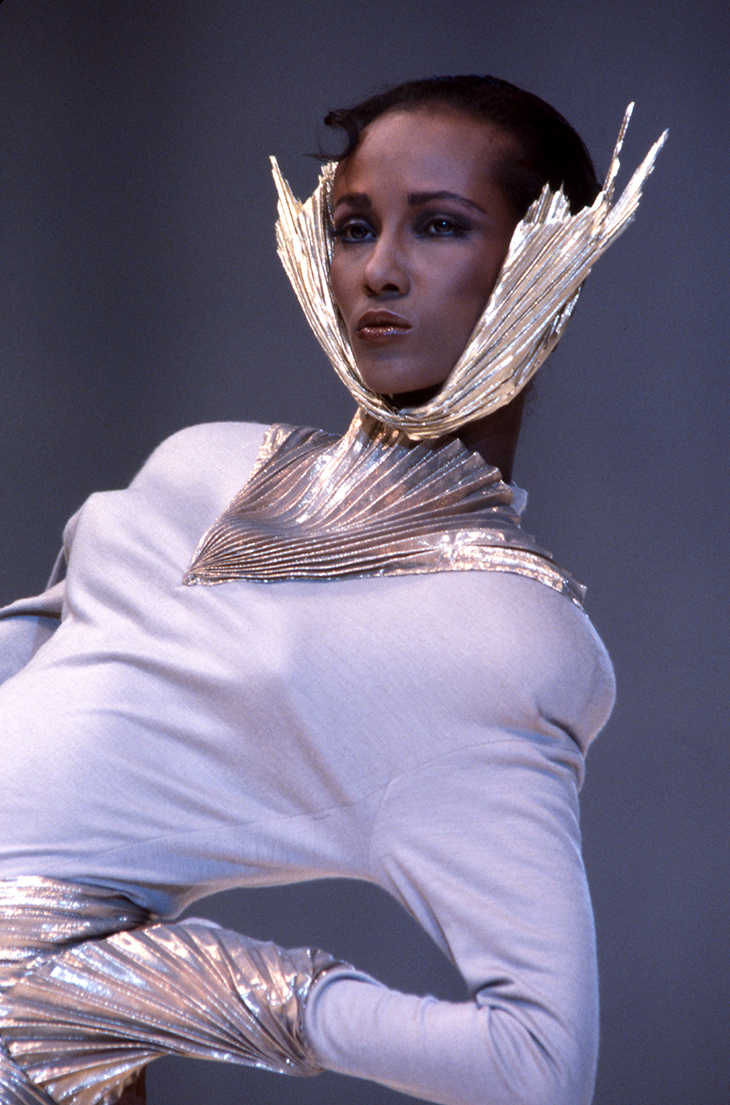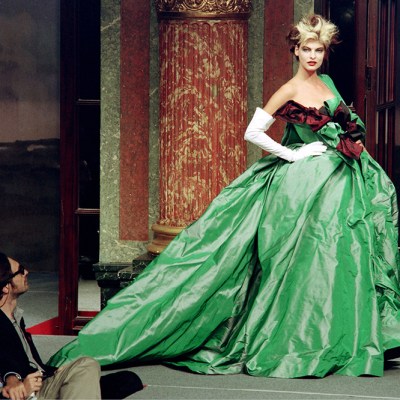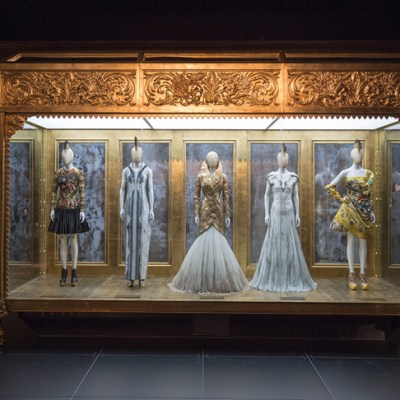‘I am not trying to seduce you. Would you like me to seduce you?’
The video for George Michael’s hit ‘Too Funky’ (1992) opens with a model in a black veil. Red-lipped and blonde, she has the imperious expression of Marlene Dietrich and the gothic high glamour of a Catholic widow. As Anne Bancroft’s famous line from The Graduate rings out, the model pulls off her veil to reveal a dress with padded shoulders and a tightly buttoned waist. She removes a square of fabric from the bodice, transforming the garment into something explicitly sexy with its translucent panel framing her cleavage and collarbones. The fashion show is beginning. Let the chaos commence.
The video was directed and costumed by Manfred Thierry Mugler. In it a bevy of supermodels including Linda Evangelista and Tyra Banks strut for the audience, trying to ignore the backstage mayhem slowly bleeding out on to the catwalk. Some of their outfits are conventionally seductive: black latex, white feathers, red tassels. Others are stranger: metallic headpieces and breastplates fit for a robot; a bustier recalling a motorcycle, complete with handles and side-mirrors for the model to steer herself a clear course. To anyone familiar with the work of the provocative French designer, the video is a ‘greatest hits’ montage of his style and preoccupations, with its exaggerated eroticism and hard edges, its love of a good show and its willingness to poke fun at the spectacle.
At the end of the Thierry Mugler show in March 1998 in Paris. Photo: Pool DUCLOS/STEVENS/Gamma-Rapho via Getty Images

‘I am not trying to seduce you. Would you like me to seduce you?’
It’s a fitting manifesto for the kind of person Mugler envisaged and wanted to dress. After his death earlier this week at the age of 73, the designer’s obituaries were filled with descriptions of his predilection for femme-fatale theatrics and larger-than-life characters. In an oral history of the filming of ‘Too Funky,’ republished on Vogue, participants in the video described Mugler as a man with an unswerving vision. He created superhumans and sexy soldiers. He understood the magnetism of celebrity star power. But he wasn’t a Gianni Versace or a Tom Ford. He was too campy, too kinky for that. His designs had a fearsome quality. Dressed in Mugler, a woman could be a Venus or a bird of paradise, but she could also be an insect, a vehicle, an uncompromising alien. Did she always intend to seduce? No. But she definitely could, if she wanted to.
Born in Strasbourg in 1948, Mugler’s life and career were defined from an early age by a taste for performance. He trained in ballet and acrobatics during his youth, then studied interior design before embarking on a fashion career in Paris in his twenties. In the mid 1970s, he launched his first label, Café de Paris. From the very beginning his designs were surreal and sculptural, scrupulously attentive to form. Emblematic of Eighties power dressing in the extreme, the silhouettes were frequently cartoonish – hourglass cuts, oversized shoulders – and the sensibility post-modern. Mugler devised a world populated with showgirls and cyborgs; human, animal and mechanical fused together with crafted precision. In doing so he pushed conventional femininity towards the point of parody (his catwalks feel inextricable from the world of drag, from his use of performers including Lypsinka to the kinds of outfit reveals that are now a staple on Drag Race). He produced shows where, no matter how high the heels or tight the corset, the models looked like they were actually having fun. This stagey-ness later found other outlets when Mugler left the brand in 2002. He created costumes for the Cirque de Soleil, outfitted Beyonce’s 2009 world tour, worked on the shows Mugler Follies in Paris and The Wyld in Berlin, and collaborated with the choreographer Wayne McGregor on a short piece in 2019.
Iman in the Thierry Mugler haute couture Autumn/Winter 1984–1985 show in March 1984 in Paris. Photo: Daniel SIMON/Gamma-Rapho via Getty Images

Often, when raking over the legacy of a designer, we turn to pictures: catwalk shots, editorials, celebrities on the red carpet. But in the case of Mugler, it’s the videos that capture the essence of his magic. It’s all in the movement. A crowd of models in shiny catsuits and huge, squat hats like blackening waxcap mushrooms stride and writhe and pose, Bob Fosse-style, to the beat. Fetishistic leather skirt suits are unzipped to reveal a meadow of appliqued pastel flowers beneath. For his tenth anniversary in 1985, Mugler held his show in the Zénith arena in Paris and invited the public along. Pat Cleveland appeared as a glittering Virgin Mary to an audience of 6,000. Ten years later (when, as fashion critic Tim Blanks points out, Mugler had the budget of a man responsible for the world’s best-selling perfume, Angel), that troupe of models in black heralded the beginning of an hour-long extravaganza including Naomi Campbell, Kate Moss and Jerry Hall as well as Rossy de Palma and Tippi Hedren, and topped off with a performance from James Brown.
Why the need for magnitude? The same impulse is visible in the photos Mugler took, his designs thrown into startling relief against skyscrapers and deserts. Perhaps it is pure creative bravado, the endpoint of someone who said ‘What if…?’ and ended up corralling his model into posing on a freezing iceberg 20 miles off the coast of Greenland. It suggests a desire to dominate the horizon too. Look, these photos seem to say, there is no skyline too high, no monument too vast, no idea too wild that I couldn’t make it happen.
In his later years, Mugler decided to re-craft his body into a taut, muscled statue. ‘It’s important,’ he said, ‘for people to be a complete realization of themselves’. Like his clothes, this felt like a rejection of softness and indeterminacy, revealing once again a devotion to the body as an endlessly malleable, perfectible thing. Such an approach is not for everyone. When I spoke to a friend the other day about Mugler, she made a face and said how much she’d hated him in the eighties. She saw his designs – and consequently his vision of womanhood – as not just restrictive, but disturbing. Right now, when the fashion industry feels vaguely adrift, full of good ideas and innovations but lacking much of the uninhibited weirdness and vision (as well as time and money) that creates a Mugler or a McQueen, the idea of genuine love-it-or-hate-it provocation feels thrilling.
The previous generation of fashion greats are currently departing too quickly. André Leon Talley, whose death was announced last week, was another example of someone who was a complete realisation of themselves: Louis Vuitton luggage, Karl Lagerfeld capes, and all. In their departure, these figures remind us of what has been lost in their absence. There is no point being nostalgic about the past. If anything, the fashion industry is currently stuck there, endlessly reviving and recycling previous decades in a merry-go-round of frilled Seventies dresses and Nineties spaghetti straps. But there are still some useful lessons that we might take from the Muglers and Talleys of the world: a commitment to excellence, even in the extreme; the value of a singular and wide-reaching imagination; the willingness to be full-throated in one’s passions, even if that risks annoying or alienating people. A love of drama too. Fashion is always, to some degree, theatre. Sometimes you just want to sit back and enjoy the show.


